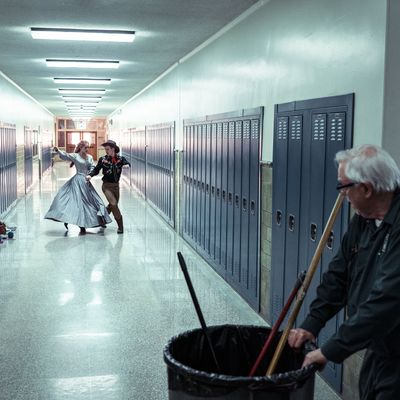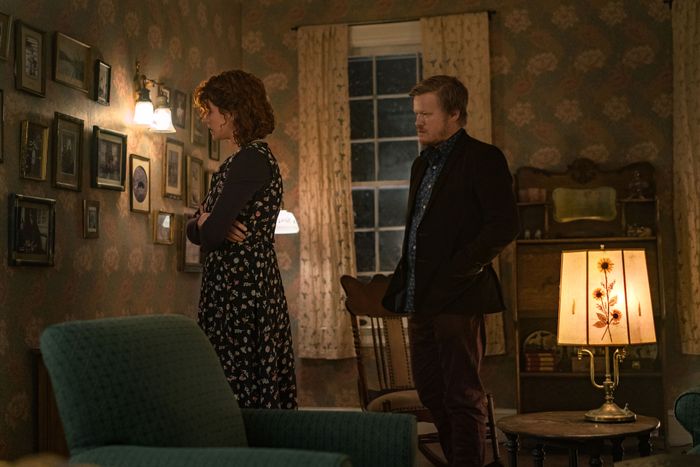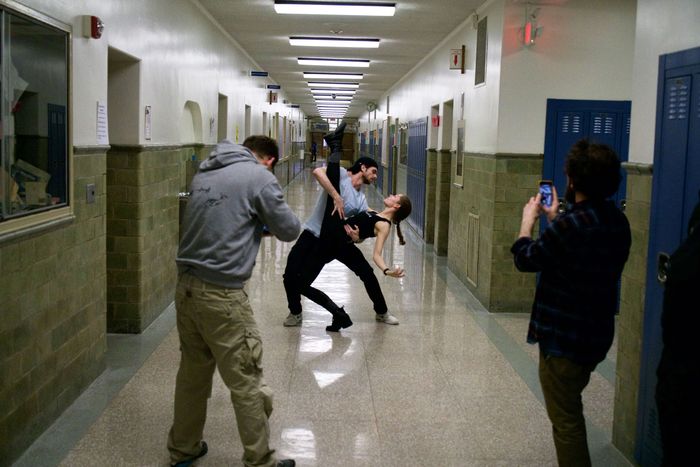
ÔÇ£ItÔÇÖs very off-putting,ÔÇØ says choreographer Peter Walker. ÔÇ£It takes you a second to accept whatÔÇÖs happening.ÔÇØ
The New York City Ballet soloist is talking about the closing arc of IÔÇÖm Thinking of Ending Things ÔÇö but really, he could be talking about most moments of Charlie KaufmanÔÇÖs head-scratching Netflix feature, adapted from Iain ReidÔÇÖs 2016 novel of the same name. Any viewer would be forgiven for wondering exactly what they just watched by the end of its over two-hour runtime, but to hear behind-the-scenes creatives like Walker, production designer Molly Hughes, and composer Jay Wadley tell it, a lot of the answers can be found within the final fantasy ballet sequence itself.
Suffice it to say, the early events of this movie are never what they seem. But letÔÇÖs set the stage anyway, keeping in mind that the identities and visages of those involved seem eerily, constantly in flux: After Lucy (played by Jessie Buckley, whoÔÇÖs listed merely as ÔÇ£Young WomanÔÇØ in the credits) endures a frighteningly surreal trip to her boyfriend JakeÔÇÖs (Jesse Plemons) farmhouse to meet his parents (Toni Collette and David Thewlis), their long, wintry drive home inexplicably brings them to JakeÔÇÖs high school. When Jake, somehow slapped with a vision of the institutionÔÇÖs elderly janitor spying on them from afar, rushes inside to give him a piece of his mind, Lucy begrudgingly follows suit, only to meet the janitor herself while wandering its empty hallways. Here, the two share a touching moment and, out of nowhere, a tearful hug good-bye. Jake then appears outside a nearby classroom, with WadleyÔÇÖs score teasing its way to the fore, as two doppelg├ñnger extensions of Jake and Lucy (Broadway dancer Ryan Steele and NYCB soloist Unity Phelan) enter behind Plemons and Buckley, respectively. And a ballet begins.
Walker says that while the ballet feels like a jarring transition away from the suspenseful narrative Kaufman was seemingly building (ÔÇ£It couldÔÇÖve turned into a slasher film where she gets murdered in the high school,ÔÇØ he posits), he believe itÔÇÖs a necessary diversion from the tension of this mysterious story. ÔÇ£ItÔÇÖs this weird thing where [the movie] actually does the opposite of what you feel it should,ÔÇØ he says. ÔÇ£WeÔÇÖre able to release some of that tension, and then it builds back up to the actual conclusion of the film.ÔÇØ
In ReidÔÇÖs novel, readers learn that the janitor is actually Jake, lonely in old age, and Lucy ÔÇö the whole trip to the farmhouse, in fact ÔÇö is simply a product of his imagination. While Kaufman has been reluctant to give his audience such a clearcut revelation, he has explained that his version of Jake is a man trapped in his own fantasies, ones informed by his consumption of popular art and media. ÔÇ£This movie is dealing with somebodyÔÇÖs experience of absorbing things that they see and how they become part of his psyche,ÔÇØ he recently told IndieWire. If we are to believe that KaufmanÔÇÖs adaptation hews more closely to ReidÔÇÖs original than heÔÇÖs willing to admit, however, then itÔÇÖs safe to assume that the ÔÇ£actual conclusion of the filmÔÇØ ÔÇö the action that follows the ballet, including a scene that begins with the janitor crying in his truck and ends with a familiar, animated pig leading him back into the school ÔÇö is a fanciful representation of the janitorÔÇÖs death and his reevaluation of the life he never lived.
Were getting late in the film by the time we get to that, and the janitor is approaching his death [and experiencing] this sort of sweeping, beautiful moment of emotion or longing, says production designer Molly Hughes, a previous Kaufman collaborator on 2014s How and Why. It sounds morbid, but as you see death approaching, do things become clearer? Its kind of like that  Its very hard to articulate something thats actually just about a feeling; the whole sequence, to me, is this overwhelming swell of longing and regret played out in a dance.
That feeling is exactly whatÔÇÖs communicated through WalkerÔÇÖs dance and WadleyÔÇÖs score. The heightened, romantic reality of the musical vignette serves as a depiction of the life Jake wished heÔÇÖd lived with the girl who got away ÔÇö or, more accurately, the one who was never his to begin with. What about when the choreographed romance and eventual wedding between the dancers is violently interrupted by the janitor killing Jake? ThatÔÇÖs an exacting thwack of reality. ItÔÇÖs indicative of a ÔÇ£fractured psyche,ÔÇØ Walker says, and highlights ÔÇ£two versions of himself that are fighting over this girl that doesnÔÇÖt even exist.ÔÇØ In the end, Jake was never meant to live out the endings of classic musicals (like Oklahoma!, a high-school staging of which plays in snippets throughout the movie and serves as the final setting of the film, where Jake recites the famous A Beautiful Mind speech and sings ÔÇ£Lonely RoomÔÇØ) that he grew up watching.
ÔÇ£We talked a lot about who these people are, and [the dancer] Ryan is like an idealized version of who Jake wishes he could be,ÔÇØ Walker explains. ÔÇ£And then this relationship between the two [dancers] is the ultimate romanticized, idealized version of a relationship. ItÔÇÖs very simple and very straightforward, but itÔÇÖs all he could imagine.ÔÇØ
This is a man who has never had a productive relationship in his life [and] doesnt know what that could possibly be or feel like, Walker continues. So we just tried to make it so sickly sweet and romantic [that] at face value, its a beautiful duet  and its surreal  Thematically maybe hes killing a part of himself or he realizes that this cant exist in the way that he wants. Theres multiple interpretations of that moment.
Wadley developed his score around the world and characterizations that Kaufman built into the film, sonically pulling less from classic musicals and more from composers he imagined Jake listening to, specifically Claude Debussy, Joseph Maurice Ravel, and Igor Stravinsky. These composers all shared the tonality he was looking to explore with a more full-fledged ballet sequence.
I just tried to make it as grand as possible, Wadley says. Since its all in his imagination, it could be as wild as we could make it  [But] if we had made the decision to do something that was ultra modern and more experimental in ways, I dont feel like that would align as much with the concept of the film and the concept of Jake creating this alternative narrative of himself by appropriating all these other elements and art forms. Approaching it with this classic, romantic, familiar language was super important to how it relates to him.
Likewise, Hughes captured JakeÔÇÖs arrested development visually by building the ballet within a high-school setting. ÔÇ£We decided to add the dance sequence in the hallway, and that was not the original intention,ÔÇØ she says, noting that theyÔÇÖd first explored filming in a black-box theater. ÔÇ£The school becomes another layer of memories piecing themselves together in a way that doesnÔÇÖt quite make sense. We donÔÇÖt always remember things the way they happen. You might think you remember something because youÔÇÖve seen a photograph of it ten times from your childhood, but you donÔÇÖt really have the memory of the actual thing. That was sort of our visual theme for the whole movie.ÔÇØ
WhatÔÇÖs most apparent in speaking with KaufmanÔÇÖs collaborators is that, while the director certainly granted them the freedom to expand on his story, the beats of the final fantasy scene were all made very clear in the original script. Walker remembers a full page of single-spaced direction for the ballet, with Kaufman explaining that the dancers run together here, the light comes up here, the janitor interrupts their nuptials here. ÔÇ£It presented a very singular vision of what was to happen, which as a choreographer is actually very helpful, so I wasnÔÇÖt making stuff up and missing the mark.ÔÇØ
ÔÇ£Because so much is abstract, itÔÇÖs like trying to get people to feel emotions and feel these concepts in a concrete visual way, and that can be really challenging,ÔÇØ Hughes says. ÔÇ£[Kaufman is] very good at just talking through the script to try and get to what those visual elements are.ÔÇØ
ÔÇ£ItÔÇÖs exciting to work with a director who has such a unique vision that allows you to really go for things,ÔÇØ Wadley adds.
And sure, while the movie might still leave you perplexed, Hughes believes its ability to force you to sit with uncomfortable feelings is commendable.
ÔÇ£When I first read it, I thought that it was beautiful, and I hope that people find it beautiful,ÔÇØ she says. ÔÇ£I hope that people sit with it and just go with it and [are not] afraid of the feelings that it provokes, because theyÔÇÖre not pleasant a lot of the time. But theyÔÇÖre very much a part of who we are as human beings. I think we spend a lot of time avoiding those feelings and avoiding memories and the ideas that he presents, but he always does such a good a job of bringing them to the surface. You have to face them.ÔÇØ



